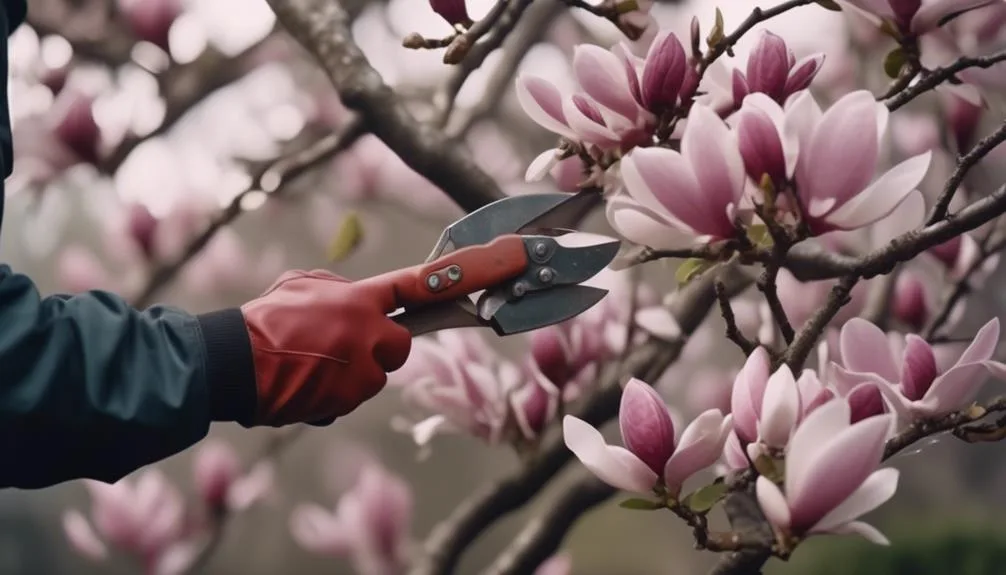Looking to learn the best time to prune your magnolia trees? We've got you covered.
Proper pruning can boost the beauty and health of these stunning trees. Our expert tips cover the right tools and techniques for promoting healthy growth.
If you're eager to master the art of magnolia tree pruning, you're in the right place.
Timing for Pruning Magnolia Trees
When it comes to timing for pruning magnolia trees, it's crucial to understand the specific growth patterns and blooming cycles of these beautiful trees. Best practices dictate that the optimal season for pruning magnolia trees is right after they finish blooming in late spring or early summer. This timing allows the tree to recover and set buds for the following year without interfering with the next season's blossoms.
Pruning during this time also reduces the risk of removing potential flower buds. It's important to visualize the tree's natural shape and growth pattern as you carefully trim any dead or damaged branches.
Tools Needed for Pruning
After timing your pruning to coincide with the completion of blooming, the next crucial step is ensuring you have the right tools for the job.
When it comes to pruning magnolia trees, having the proper pruning tools is essential for achieving the best results. You'll need a sharp pair of bypass pruners for smaller branches and a pruning saw for thicker ones. Bypass pruners have a scissor-like cutting action, making clean cuts that promote healing. A pruning saw, on the other hand, is designed to handle larger branches with ease.
Safety precautions are also vital, so don't forget to wear gloves, safety goggles, and sturdy footwear to protect yourself from potential hazards. Additionally, always ensure that your tools are clean and well-maintained to prevent the spread of diseases between plants.
Techniques for Removing Dead Branches
To effectively remove dead branches from your magnolia tree, begin by inspecting the tree for any signs of decay or damage. Dead branches not only detract from the tree's appearance but can also pose a risk to the overall health of the tree. When pruning dead branches, it's important to use proper techniques to ensure disease prevention and proper healing. Here's a simple guide to help you remove dead branches effectively:
| Dead Branch Removal Techniques | Benefits |
|---|---|
| 1. Clean Cut | Prevents tearing and promotes proper healing. |
| 2. Prune at the Collar | Encourages natural healing and reduces the risk of disease. |
| 3. Disinfect Tools | Prevents the spread of disease between cuts. |
Pruning to Promote Healthy Growth
Inspecting your magnolia tree for signs of decay or damage will set the stage for promoting healthy growth through proper pruning techniques. Once you've removed dead branches, focus on shaping the tree to encourage new growth. Use sharp, clean tools to make precise cuts at a 45-degree angle just above a bud or lateral branch. This will help the tree heal quickly.
Additionally, consider fertilization methods to provide essential nutrients for robust growth. A balanced fertilizer in early spring can support the development of healthy foliage and vibrant blooms.
Furthermore, ensure disease prevention by removing any diseased or infested branches promptly. This will help maintain the overall health of the tree and prevent the spread of any potential issues.
With these techniques, you can foster a thriving magnolia tree for years to come.
Tips for Pruning Magnolia Trees
Consider using sharp, clean tools to make precise cuts at a 45-degree angle just above a bud or lateral branch when pruning your magnolia tree for optimal results. Here are some tips to help you achieve the best results:
- Timing: Prune your magnolia tree during late winter or early spring to encourage new growth and minimize stress on the tree.
- *Visualize*: Imagine the tree's future shape and growth pattern as you make each cut, enhancing its aesthetic appeal over time.
- Technique: Focus on removing dead, damaged, or crossing branches to improve the tree's overall health and appearance.
- *Pruning Benefits*: By removing excess growth, you allow the tree to direct more energy into producing vibrant, beautiful blooms, enhancing its aesthetic appeal.
Conclusion
By following these pruning techniques, your magnolia trees will flourish year-round, boasting healthy growth and exquisite blooms.
Remember to prune at the appropriate time, use the right tools, and prioritize the removal of dead branches.
With these mindful practices, your landscape will continue to be graced with the natural elegance of thriving magnolia trees.
Happy pruning!

My interest in trees started when I first saw the giant sequoias in Yosemite.
I was a teenager then, and I remember thinking, “I need to learn more about this.”
That moment stuck with me.
A few years later, I went on to study forestry at Michigan Tech.
Since graduating, I’ve worked in a mix of hands-on tree care and community education.
I’ve spent over ten years helping people understand how to plant, maintain, and protect the trees in their neighborhoods.
I don’t see trees as just part of the landscape.
They are living things that make a real difference in our daily lives.
